Dark Nebula in Orion – Constellation Guide (original) (raw)
The Horsehead Nebula (B33) is a famous dark nebula located in the constellation Orion. It is part of the Orion Molecular Cloud Complex, one of the nearest active regions of star formation to the Sun. The nebula lies at an approximate distance of 1,375 light-years from the solar system. It was imaged by the James Webb Space Telescope (JWST) in 2024.
The Horsehead Nebula is one of the most identifiable nebulae in the sky. It appears in the southern portion of a dense dark dust cloud catalogued as Lynds 1630 (LND 1630).
The swirling clouds of gas and dark dust that form the nebula have the shape of a horse’s head, giving the nebula its name. The dark dust clouds are made visible by the pinkish glow of hydrogen gas located behind the nebula.
In images, the darkness of the Horsehead Nebula stands out against the emission nebulosity in the background. The red glow of the ionized hydrogen gas behind the nebula is caused by the nearby bright star Sigma Orionis, which partly illuminates the Horsehead.
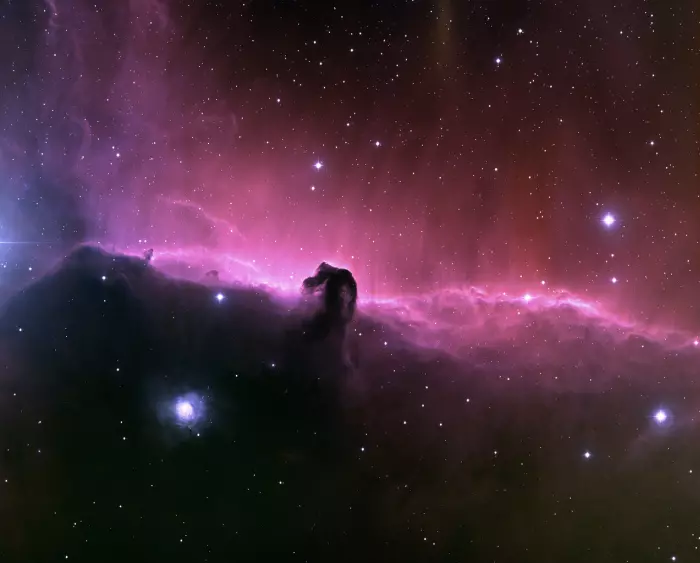
This exceptional image of the Horsehead nebula was taken at the National Science Foundation’s 0.9-meter telescope on Kitt Peak with the NOAO Mosaic CCD camera. Located in the constellation of Orion, the Hunter, the Horsehead is part of a dense cloud of gas in front of an active star-forming nebula known as IC434. This false-color image was created by combining emission-line images taken in hydrogen-alpha (red), oxygen [OIII] (green) and sulfur [SII] (blue). Image credit: T. A. Rector (NOIRLab/NSF/AURA) and Hubble Heritage Team (STScI/AURA/NASA) (CC BY 4.0)
Sigma Orionis is a multiple star system composed of exceptionally hot stars of the spectral types O, B, and A. The brightest components are over 10 times more massive than the Sun and destined to go out as supernovae when they reach the end of their short life cycles. The stars are less than 2 million years old.
The brighter star visible in this area of the sky in images is Alnitak (Zeta Orionis), the easternmost star of the Belt of Orion. The hot blue supergiant is located in the foreground and is not related to the Horsehead.
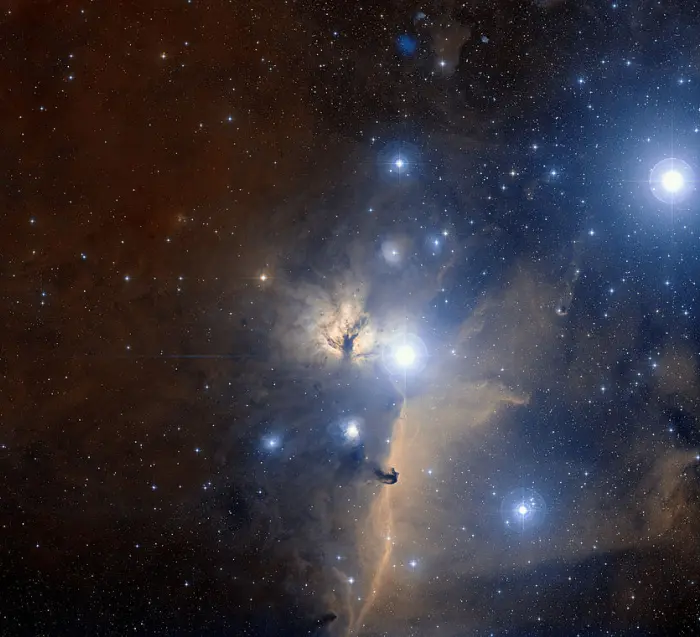
This spectacular visible light wide-field view of part of the famous belt of the great celestial hunter Orion shows the region of the sky around the Flame Nebula. The whole image is filled with glowing gas clouds illuminated by hot blue young stars. It was created from photographs in red and blue light forming part of the Digitized Sky Survey 2. The field of view is approximately three degrees. Image: ESO and Digitized Sky Survey 2 (CC BY 4.0)
The Horsehead Nebula is one of the most popular astrophotography targets in the sky. Its unusual shape and the colourful surroundings of the Orion’s Belt region make it a favourite for amateur astronomers.
The dark nebula appears along the edge of the large emission nebula IC 434. IC 434 is an active star-forming region located approximately 1,500 light-years away. It has an apparent magnitude of 7.3. The Horsehead appears silhouetted against it. The nebula IC 434 was discovered by the German-born British astronomer William Herschel in 1786 and the Horsehead was first recorded a full century later, in the late 1800s.
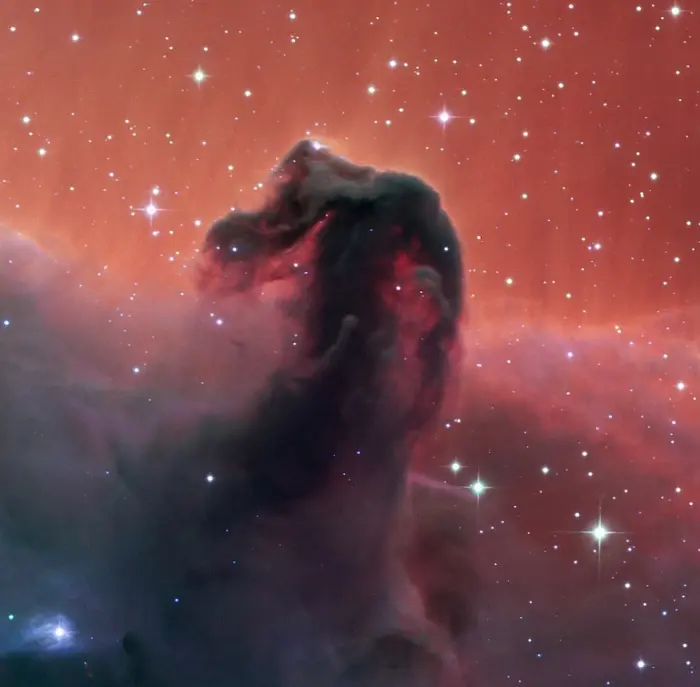
This first light image from the Callisto telescope at the SPECULOOS Southern Observatory (SSO) shows the famous Horsehead Nebula . First light for a newly commissioned telescope is a tremendously exciting time, and usually well-known astronomical objects such as this are captured to celebrate a new telescope commencing operations. Image: SPECULOOS Team/E. Jehin/ESO (CC BY 4.0)
The Horsehead Nebula formed from a collapse of an interstellar cloud of material and appears dark mainly because it consists of thick dust. It can only be seen because its obscuring dust is backlit by the brighter nebula IC 434. The nebulous region that forms the horse’s head is part of a larger dust cloud that blocks the light from the star-forming region behind it.
The Horsehead Nebula is mostly composed of cold molecular hydrogen, which does not emit any light and radiates very little heat. The nebula’s clouds are very thick and block the light of any stars within and behind the nebula. A near-infrared image taken by the Hubble Space Telescope (HST) provided astronomers with a better look at the nebula’s structure and the stars embedded within it as well as those located in the background.
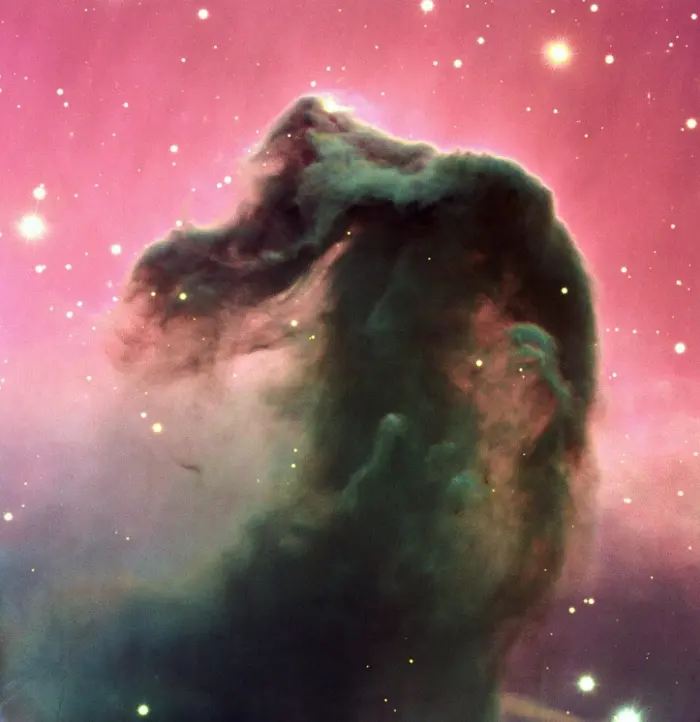
A reproduction of a composite colour image of the Horsehead Nebula and its immediate surroundings. It is based on three exposures in the visual part of the spectrum with the FORS2 multi-mode instrument at the 8.2-m KUEYEN telescope at Paranal. It was produced from three images, obtained on February 1, 2000, with the FORS2 multi-mode instrument at the 8.2-m KUEYEN Unit Telescope and extracted from the VLT Science Archive Facility . The frames were obtained in the B-band (600 sec exposure; wavelength 429 nm; FWHM 88 nm; here rendered as blue), V-band (300 sec; 554 nm; 112 nm; green) and R-band (120 sec; 655 nm; 165 nm; red). The original pixel size is 0.2 arcsec. The photo shows the full field recorded in all three colours, approximately 6.5 x 6.7 arcmin 2. Image credit: European Southern Observatory (CC BY 4.0)
The nebula appears shadowy in optical light, but transparent at infrared wavelengths, revealing the Milky Way and galaxies in the background. The bright spots at the Horsehead Nebula’s base mark very young stars that are still in the process of forming.
The Horsehead contains protostars, but its clouds are so dense that they block the visible light of newly formed stars. If there are young stars in the nebula, they will consume a lot of the nebula’s material in the process of forming.
The nebula will dissipate in the next 5 billion years. Its dust clouds will be gradually eroded away by the ultraviolet light of the luminous young stars in the vicinity. The strong radiation of the young stars will tear apart the nebula’s gas molecules and blow away the dust through a process known as photodissociation. Eventually, the view of the nebula will be replaced by one of massive young blue stars.
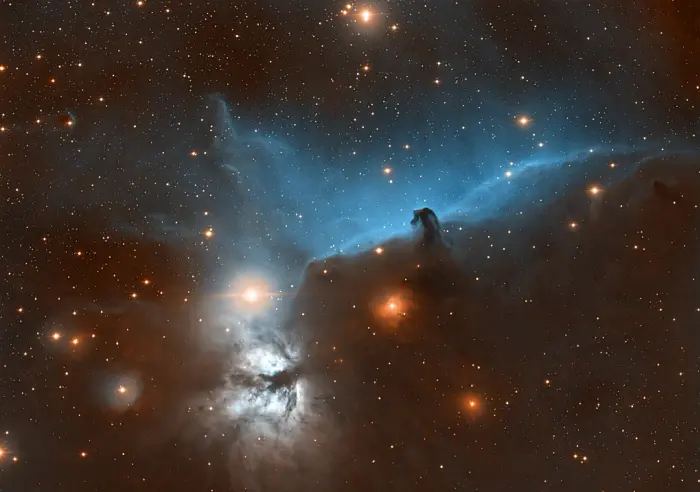
The Horsehead and Flame nebulae. Credit: Dylan O’Donnell, deography.com. Taken with Celestron Edge Hd 9.25″ / Hyperstar / Baader highspeed Ha / EQ6. Processing Pixinsight and Photoshop. (CC0 1.0)
The Horsehead Nebula is one of the best-known photodissociation regions (PDRs) in the sky. Also known as photon-dominated regions, PDRs are mostly neutral regions in which the ultraviolet light (photons) from massive young stars strongly affects the chemistry of the gas and acts as a main source of heat.
PDRs are typically found in regions of dense interstellar gas that are cold and dense enough to remain neutral but not quite dense enough to fend off the piercing far ultraviolet photons from exceptionally massive stars.
A 2023 study led by C. Hernández-Vera of the Instituto de Astrofísica, Pontificia Universidad Católica de Chile, reported a sharp transition between ionized and molecular gas in the Horsehead Nebula. The team found evidence of a narrow neutral atomic layer at the surface of the nebula, between the molecular gas and the H II region. The layer was found to be up to 600 astronomical units across, considerably thinner than the one detected in the Orion Bar photodissociation region. The findings were based on observations with the Atacama Large Millimeter/submillimeter Array (ALMA) in the Atacama desert in Chile from October to December 2019.
A young stellar object, catalogued as IRAS 05383−0228, was identified in the nebula in a study published in 1984. The peak temperatures of the Horsehead’s neck, mane and western ridge occur along the western rim, near the young stellar object.
A study published in The Astronomical Journal in 2009 identified two bona fide young stellar objects (YSOs) – designated B33-1 and B33-28 – and five candidate protostars in the Horsehead Nebula. The protostars lie at the nebula’s western limb. The data indicated that they are in the same phase of their life cycles and formed at about the same time. B33-1 appears to be coming out of a cavity that is visible in optical wavelengths, while B33-28 is optically invisible. The candidate YSOs range from foreground to partly embedded to fully embedded objects. The ages of the two protostars are similar to the formation timescale of the nebula. The study found no evidence of sequential star formation in the Horsehead.
The streaks of nebulosity in the foreground of the Horsehead are likely caused by strong magnetic fields, which funnel the streams of gas from the nebula.
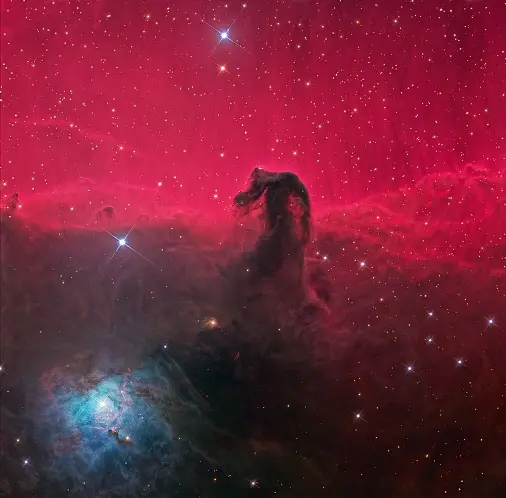
Horsehead Nebula (also known as Barnard 33 in emission nebula IC 434) is a dark nebula in the constellation Orion. The image is a frame mosaic taken with 5 different filters, standard Red – Green – Blue with details enhanced with narrowband data of Hydrogen-alpha (Hα) and O III. The Hα was color-mapped to red and the O III to teal. So it is a representative color image consisting of over 900 minutes of exposure time. Image: Ken Crawford (CC BY-SA 3.0)
Facts
The Horsehead Nebula is one of the best-known dark nebulae in the sky, along with the Coalsack Nebula in the constellation Crux, the Great Dark Horse in Ophiuchus, and the Dark Doodad Nebula in Musca.
The nebula was discovered by the Scottish astronomer Williamina Fleming on a photographic plate at the Harvard College Observatory in 1888. Fleming worked as a human “computer,” helping with the processing of astronomical data and the photographic classification of stellar spectra. She was one of the founding members of the Harvard Computers. She was hired by Edward Charles Pickering, the director of the observatory, in whose home she had previously worked as a maid.
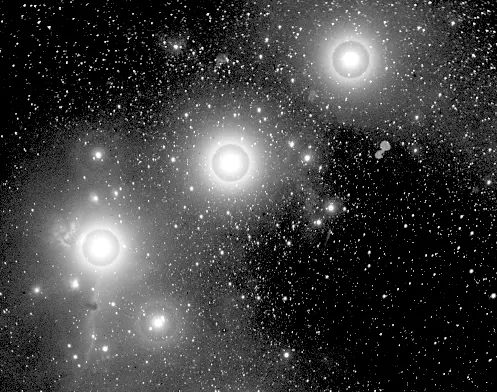
Portion of Plate b2312 showing the discovery image of the Horsehead Nebula in the collection. Taken on February 7, 1888 from Cambridge with the 8-inch Bache Doublet, Voigtlander
Fleming described the bright nebula around the Horsehead (IC 434) as having “a semicircular indentation 5 minutes in diameter 30 minutes south of Zeta Orionis.” She was not credited for the discovery of the Horsehead until 1908, when the second Dreyer Index Catalogue was published. Her entire work had until that point been attributed to Pickering.
The Horsehead Nebula is catalogued as Barnard 33 (B33) in the Barnard Catalogue of Dark Markings in the Sky (1919), compiled by the American astronomer Edward Emerson Barnard. E. E. Barnard was one of the first astronomers to describe the nebula. He wrote, “Dark mass, diam. 4′, on nebulous strip extending south from ζ Orionis.” He photographed the nebula from the Lick Observatory in California in 1894. The first person to use the name Horsehead is unknown.
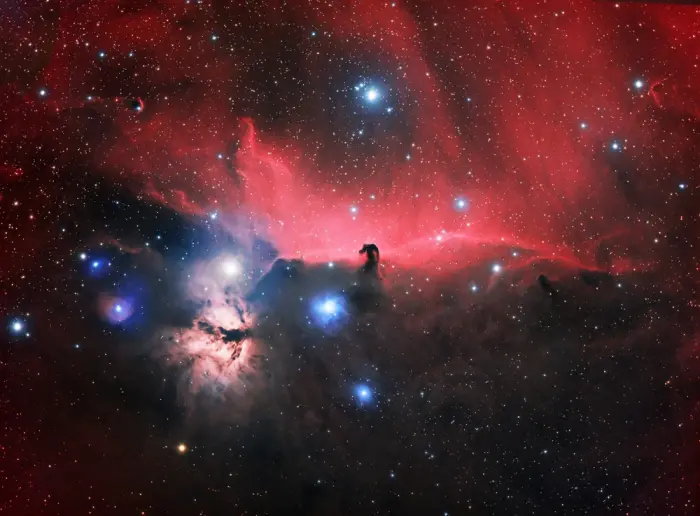
Horsehead and Flame nebulae, 384mm scope Ha-RGB, imaged with amateur equipment. 384mm refractor, 1600MM camera and an HEQ5 mount, credit: Wikimedia Commons/Stephanh (CC BY-SA 4.0)
The Horsehead Nebula is part of the Orion Molecular Cloud Complex, a vast star-forming region that contains a multitude of stars less than 12 million years old. The Orion complex contains two giant molecular clouds, Orion A and Orion B. The Horsehead is part of the Orion B molecular cloud, which also contains the emission nebula IC 434, the Flame Nebula (NGC 2024), the reflection nebula Messier 78, and the nearby McNeil’s Nebula.
The Orion B cloud hosts several star-forming regions, the largest of which is the open cluster within the Flame Nebula. The dark lanes intersecting the Flame Nebula may be part of the same dark cloud that forms the Horsehead.
The Orion B molecular cloud was imaged by ESA’s Herschel Space Observatory in 2010 and 2011. The image provided astronomers with a far-infrared view of the star-forming regions within Orion B and allowed them to map the cloud. The Horsehead Nebula appears at the right edge of the cloud. It was sculpted by the strong stellar winds from the young clusters of massive stars that were born in this region.
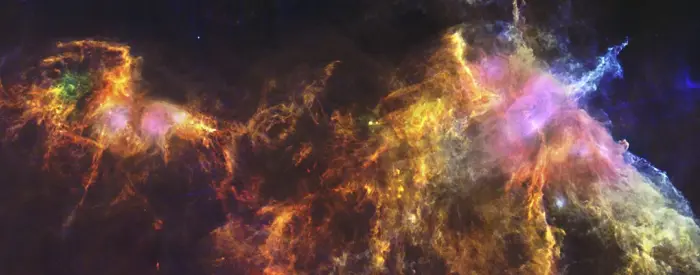
The Horsehead Nebula resides in the constellation Orion, about 1300 light-years away, and is part of the vast Orion Molecular Cloud complex. The Horsehead appears to rise above the surrounding gas and dust in the far right-hand side of this scene, and points towards the bright Flame Nebula. Intense radiation streaming away from newborn stars heats up the surrounding dust and gas, making it shine brightly to Herschel’s infrared-sensitive eyes (shown in pink and white in this image). To the left, the panoramic view also covers two other prominent sites where massive stars are forming, NGC 2068 and NGC 2071. Extensive networks of cool gas and dust weave throughout the scene in the form of red and yellow filaments, some of which may host newly forming low-mass stars. Credit ESA/Herschel/PACS, SPIRE/N. Schneider, Ph. Andr, V. Knyves (CEA Saclay, France) for the Gould Belt survey Key Programme (PD)
Hubble Space Telescope image
In April 2013, the Hubble Space Telescope photographed the nebula in astounding detail, revealing two new stars located in the nebula’s top ridge. One of these stars was reported to be emitting a harsh ultraviolet glare that is slowly stripping away the cloud.
“Gas clouds surrounding the Horsehead already have dissipated, but the tip of the jutting pillar contains a slightly higher density of hydrogen and helium, laced with dust,” said NASA. “This casts a shadow that protects material behind it from being stripped away by intense stellar radiation evaporating the hydrogen cloud, and a pillar structure forms.”
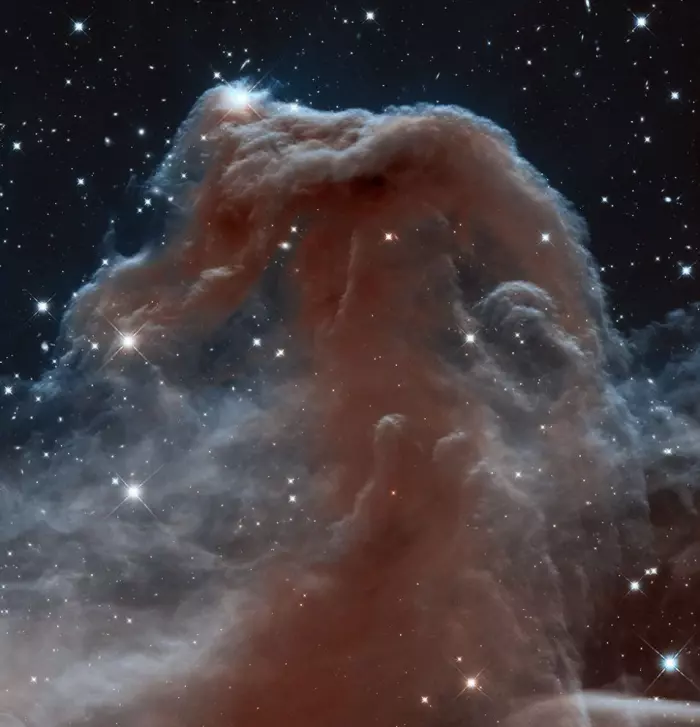
Rising from a sea of dust and gas like a giant seahorse, the Horsehead nebula is one of the most photographed objects in the sky. NASA’s Hubble Space Telescope took a close-up look at this heavenly icon, revealing the cloud’s intricate structure. This 11th anniversary release image was composed by the Hubble Heritage Team, which superimposed Hubble data onto ground-based data (limited to small triangular regions around the outer edge of the image). Ground-based image courtesy of Nigel A. Sharp (NOAO/AURA/NSF) taken at the 0.9-meter telescope on Kitt Peak. Image credit: NASA, NOAO, ESA and The Hubble Heritage Team (STScI/AURA); Acknowledgment: K. Noll (Hubble Heritage PI/STScI), C. Luginbuhl (USNO), F. Hamilton (Hubble Heritage/STScI) (CC BY 4.0)
At near-infrared wavelengths, the nebula’s material absorbs much less light, revealing the distribution of gas that will be accreted by protostars in the process of forming. The young star at the top left edge of the Horsehead Nebula has gathered material from the surrounding clouds of gas and dust. Its powerful radiation is eroding the remaining material in the vicinity.
The jutting pillar that forms the Horsehead has a higher density of helium and hydrogen, which makes it hard to erode. While the gas clouds that surrounded the nebula have already dissipated, it will be another five million years before the pillar dissipates too.
Euclid telescope image
The celestial Horsehead was imaged by ESA’s Euclid space telescope in 2023. Launched in July 2023, the Euclid telescope was developed by ESA to provide new insights into dark matter and dark energy by measuring the rate at which the universe is expanding.
The Euclid image of the Horsehead Nebula will help astronomers uncover new infant stars, brown dwarfs, and young Jupiter-mass planets in the region. The data obtained by Euclid will provide them with new insights into the process of star formation in special conditions. In the Horsehead, these conditions are caused by the intense radiation of Sigma Orionis.
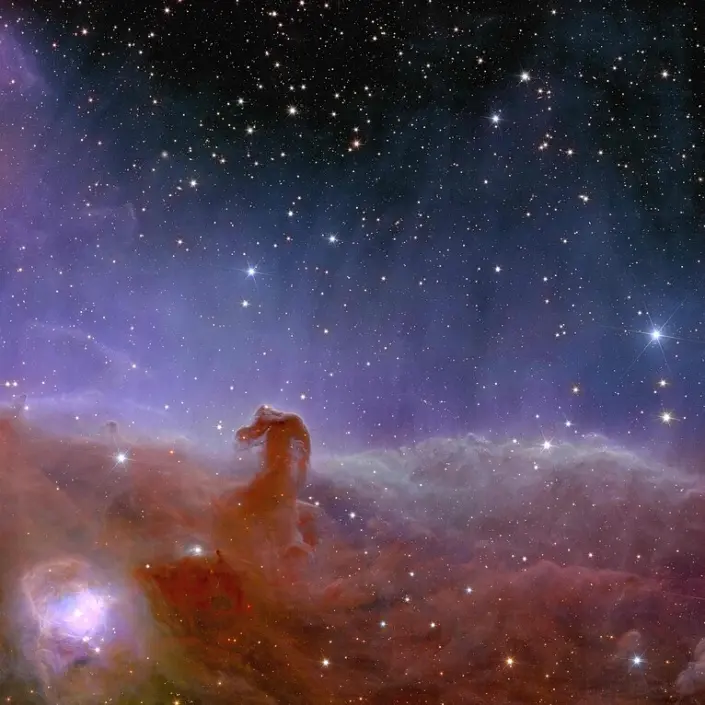
Euclid shows us a spectacularly panoramic and detailed view of the Horsehead Nebula, also known as Barnard 33 and part of the constellation Orion. At approximately 1375 light-years away, the Horsehead—visible as a dark cloud shaped like a horse’s head—is the closest giant star-forming region to Earth. It sits just to the south of star Alnitak, the easternmost of Orion’s famous three-star belt, and is part of the vast Orion molecular cloud.
Many other telescopes have taken images of the Horsehead Nebula, but none of them are able to create such a sharp and wide view as Euclid can with just one observation. Euclid captured this image of the Horsehead in about one hour, which showcases the mission’s ability to very quickly image an unprecedented area of the sky in high detail. Image credit: ESA/Euclid/Euclid Consortium/NASA image processing by J.-C. Cuillandre (CEA Paris-Saclay) G. Anselmi (CC BY-SA 3.0 IGO)
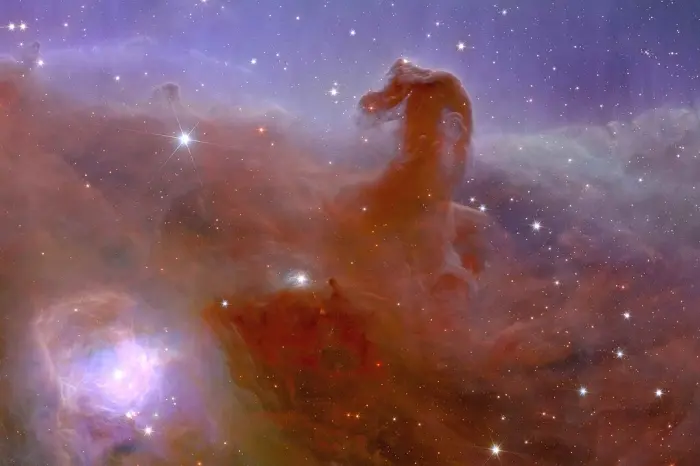
This is a cutout from Euclid’s full view of the Horsehead Nebula is a the resolution of the NISP instrument. Image credit: ESA/Euclid/Euclid Consortium/NASA image processing by J.-C. Cuillandre (CEA Paris-Saclay) G. Anselmi (CC BY-SA 3.0 IGO)
James Webb Space Telescope image
The Horsehead Nebula was captured by NASA and ESA’s James Webb Space Telescope (JWST) in 2024. The images taken with Webb’s MIRI and NIRCam instruments were released in April. They are the sharpest images of the Horsehead taken in the infrared.
The NIRCam image captured the top of the “horse’s mane,“ a region of cold molecular hydrogen that appears blue in the image.
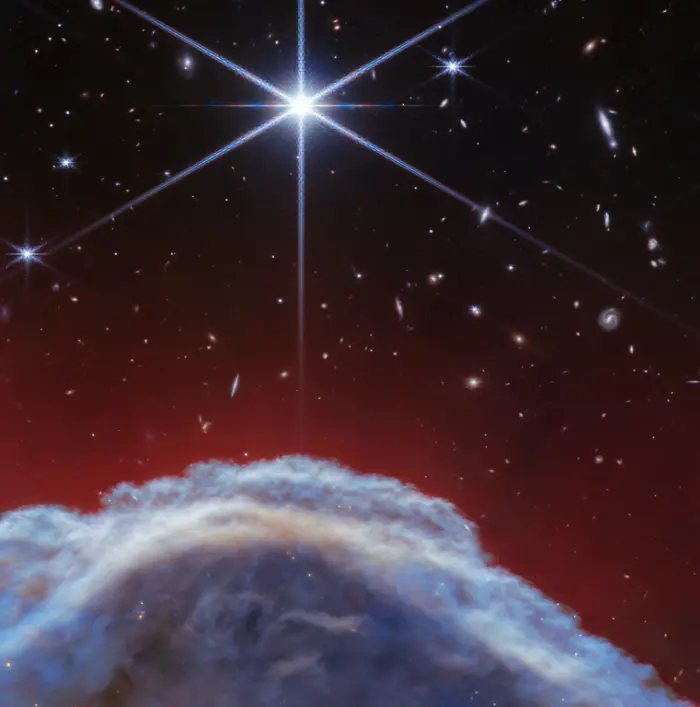
This image of the Horsehead Nebula from NASA’s James Webb Space Telescope focuses on a portion of the horse’s “mane” that is about 0.8 light-years in width. It was taken with Webb’s NIRCam (Near-infrared Camera). The ethereal clouds that appear blue at the bottom of the image are filled with a variety of materials including hydrogen, methane, and water ice. Red-colored wisps extending above the main nebula represent both atomic and molecular hydrogen. In this area, known as a photodissociation region, ultraviolet light from nearby young, massive stars creates a mostly neutral, warm area of gas and dust between the fully ionized gas above and the nebula below. As with many Webb images, distant galaxies are sprinkled in the background.
This image is composed of light at wavelengths of 1.4 and 2.5 microns (represented in blue), 3.0 and 3.23 microns (cyan), 3.35 microns (green), 4.3 microns (yellow), and 4.7 and 4.05 microns (red). Image credit: NASA, ESA, CSA, Karl Misselt (University of Arizona), Alain Abergel (AIM Paris-Saclay) (CC BY 4.0)
The MIRI instrument provided a detailed view of a portion of the mane, revealing the glow of the polycyclic aromatic hydrocarbons (PAHs) and dusty silicates in the dark nebula.
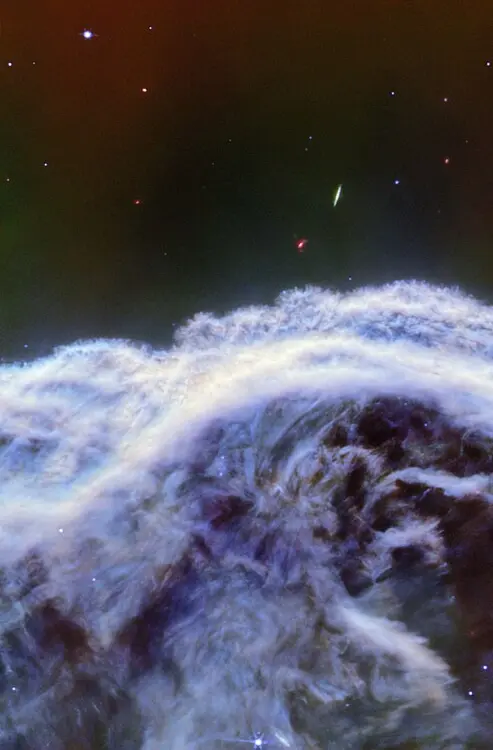
This image of the Horsehead Nebula from NASA’s James Webb Space Telescope focuses on a portion of the horse’s “mane.” It was taken with Webb’s MIRI (Mid-Infrared Instrument). Image credit: NASA, ESA, CSA, Karl Misselt (University of Arizona), Alain Abergel (IAS, CNRS) (CC BY 4.0)
Location
The Horsehead Nebula is easy to find because it lies in the region of Orion’s Belt, one of the most recognizable asterisms in the sky. The nebula appears just south of Alnitak, the left (or easternmost) star of the Belt. It forms a triangle with Alnitak and the fainter Sigma Orionis.
The Horsehead Nebula appears in the same area as the emission and reflection nebula NGC 2023, the reflection nebula IC 435, and the emission nebula NGC 2024, better known as the Flame Nebula, which is ionized by Alnitak.
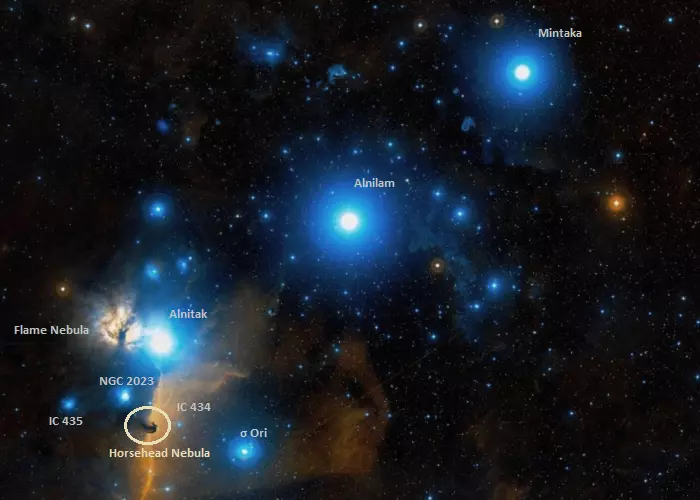
The location of the Horsehead Nebula near Orion’s Belt, image: Wikisky
Located just east of Alnitak, the Flame Nebula is a good starting point for finding the Horsehead. If the Flame Nebula is visible in a telescope, then the Horsehead may be as well. If it is not, then either the sky is not dark enough or a larger telescope is required.
The Horsehead Nebula is a challenging target for amateur telescopes. It appears as a small, faint greyish patch surrounded by brighter regions of nebulosity, and it is somewhat washed out by the light of the bright Alnitak. Visually, it is best observed in 10-inch or larger telescopes with H-beta filters. Because it appears silhouetted against the faint IC 434, it requires exceptionally clear, dark skies. The horse’s snout can be spotted in 16-inch telescopes.
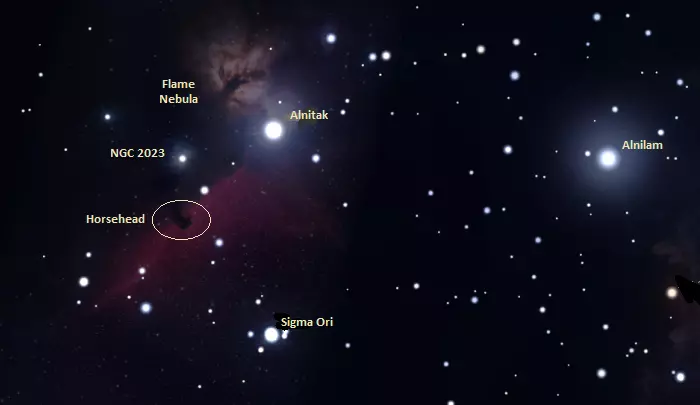
The location of the Horsehead Nebula, image: Stellarium
The nebula is best seen in long-exposure photographs, which capture details that the human eye cannot.
The nebula NGC 2023 appears about 15 arcminutes northeast of the Horsehead. It is one of the largest reflection nebulae in the sky, about 10 arcminutes across. It lies at a similar distance to the Horsehead, about 1,300 light-years away. The nebula reflects the light of the young hot blue Herbig Ae/Be star HD 37903. The region around the reflection nebula is formed of ionized gases and shines as an emission nebula.
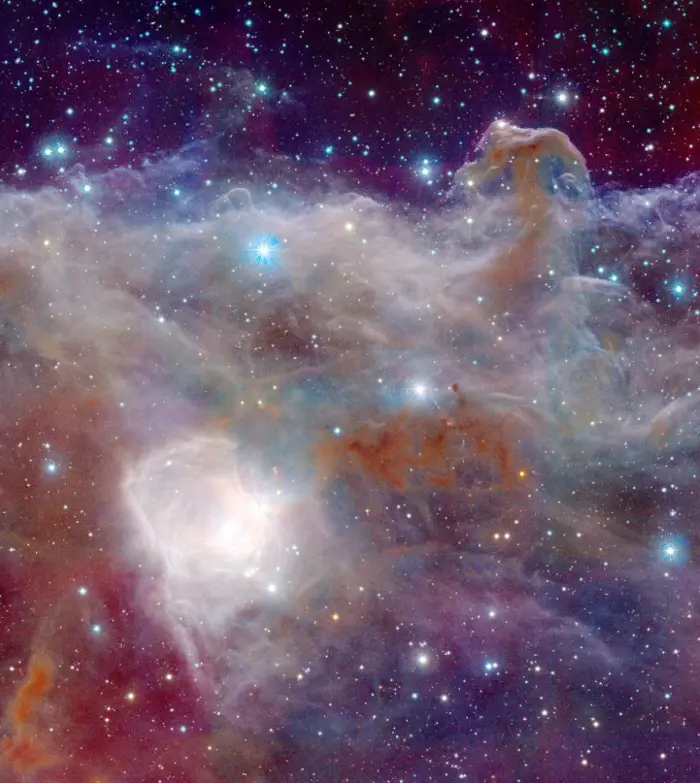
The wide-field VISTA view includes the glow of the reflection nebula NGC 2023, just below centre, and the ghostly outline of the Horsehead Nebula (Barnard 33) towards the lower right. Credit: ESO/J. Emerson/VISTA (CC BY 4.0)
The best time of the year to observe the Horsehead Nebula and other deep sky objects in Orion is during the month of January, when the constellation is prominent in the evening sky. Orion is one of the 15 equatorial constellations, visible from most locations on Earth for at least part of the year. It is particularly conspicuous in the evening during the northern hemisphere winter and southern hemisphere summer but can be seen for most of the year at some point in the night.
Horsehead Nebula – Barnard 33
| Constellation | Orion |
|---|---|
| Right ascension | 05h 40m 59.0s |
| Declination | −02° 27′ 30.0″ |
| Apparent magnitude | 6.8 |
| Apparent size | 8 x 6 arcminutes |
| Distance | 1,375 ± 54 light-years (422 ± 17 parsecs) |
| Radius | 3.5 light-years |
| Names and designations | Horsehead Nebula, B33, Barnard 33, LDN 1630, IC 434 |